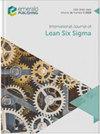A toolset for complex decision-making in analyze phase of Lean Six Sigma project: a case validation
IF 3.7
2区 工程技术
Q2 ENGINEERING, INDUSTRIAL
引用次数: 5
Abstract
Purpose The analyze phase of Lean Six Sigma (LSS) project is an important phase where the project heads and organizational directors need to select the critical issues for further improvements. The present work is primarily focused on analyze phase of LSS project to prioritize the critical to quality (CTQ) in a particular case industry. Design/methodology/approach The CTQ prioritization is being done based on the five evaluation criteria found from the literature. The weights of the criteria are determined through the modified digital logic (MDL) method. The identified CTQs in assembly section of case industry have been ranked through the gray relational analysis (GRA) under fuzzy environment. The results of the study have been validated using fuzzy VlseKriterijumska Optimisacija I Kompromisno Resenje (VIKOR). Findings It is found that the “cost” criterion is the most significant among other criteria with MDL weight of 0.3. Through fuzzy-GRA, out of ten identified CTQs, non-availability of rack system is found to be the most critical issue in assembly section of case industry. The perceptions of industrial manager and production head of case industry are strongly in favor of the obtained results and have implemented the suggested solutions. Originality/value To sustain in the competitive environment and produce quality product at right time, organizations need to control their CTQs as per their criticality. For this, the decision-making becomes quite complex to select the most critical factors because of the fascinating nature of various criteria and sub-criteria. The present study is the first attempt that has implemented the multi-criteria decision-making approach in analyze phase of LSS project.精益六西格玛项目分析阶段复杂决策的工具集:案例验证
目的精益六西格玛(LSS)项目的分析阶段是项目负责人和组织主管需要选择关键问题进行进一步改进的重要阶段。目前的工作主要集中在LSS项目的分析阶段,以确定特定行业中关键质量(CTQ)的优先级。设计/方法论/方法基于文献中的五个评估标准对CTQ进行优先排序。通过改进的数字逻辑(MDL)方法来确定准则的权重。在模糊环境下,通过灰色关联分析(GRA)对案例行业装配环节中识别出的CTQ进行了排序。该研究的结果已使用模糊VlseKriterijumska Optimisacija I Kombrisno Resenje(VIKOR)进行了验证。结果发现,在MDL权重为0.3的其他标准中,“成本”标准最为显著。通过模糊GRA,在已识别的十个CTQ中,机架系统的不可用性是机箱行业装配部门最关键的问题。案例行业的行业经理和生产负责人强烈支持所获得的结果,并实施了建议的解决方案。独创性/价值为了在竞争环境中维持并在正确的时间生产出高质量的产品,组织需要根据其关键性控制其CTQ。为此,由于各种标准和子标准的迷人性质,选择最关键因素的决策变得相当复杂。本研究是在LSS项目分析阶段实现多准则决策方法的首次尝试。
本文章由计算机程序翻译,如有差异,请以英文原文为准。
求助全文
约1分钟内获得全文
求助全文
来源期刊

International Journal of Lean Six Sigma
Engineering-Industrial and Manufacturing Engineering
CiteScore
8.90
自引率
15.00%
发文量
46
期刊介绍:
Launched in 2010, International Journal of Lean Six Sigma publishes original, empirical and review papers, case studies and theoretical frameworks or models related to Lean and Six Sigma methodologies. High quality submissions are sought from academics, researchers, practitioners and leading management consultants from around the world. Research, case studies and examples can be cited from manufacturing, service and public sectors. This includes manufacturing, health, financial services, local government, education, professional services, IT Services, transport, etc.
 求助内容:
求助内容: 应助结果提醒方式:
应助结果提醒方式:


